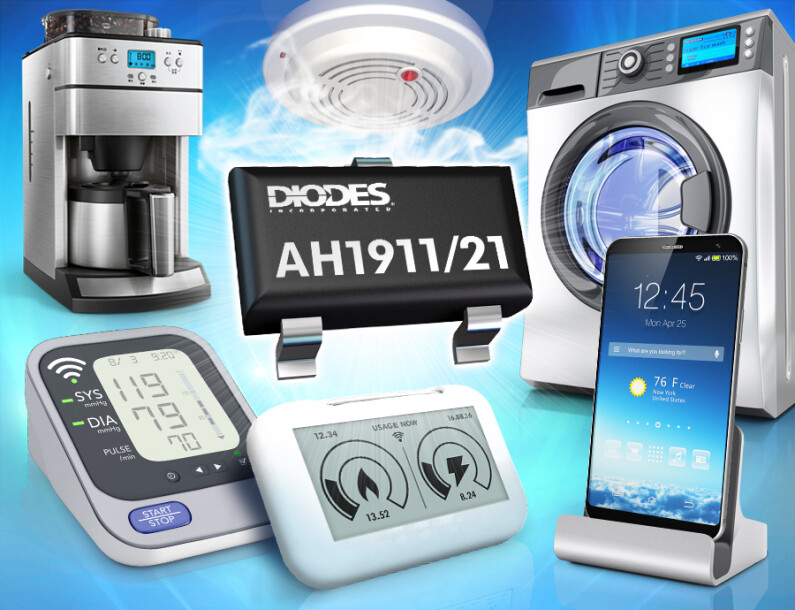Why Hall Effect Switches Play a Crucial Role in IoT

By Charles Kuo, Worldwide Sensor Marketing Manager
Many words have been written about how the Internet of Things (IoT) will transform the lives of everyone. What is less often said is that at the heart of the IoT is the humble sensor, which enables previously inanimate objects to communicate with each other and to be controlled and monitored.
For the IoT to reach its full potential around the globe, sensors must become smarter than ever. They must be brought together to share information and generate the required data at the network’s edge - and that means sensor fusion.
Sensor fusion in IoT
Disparate sensors are limited in their effectiveness until they are connected in the same way that synapses connect neurons in the human brain to communicate with the body’s sensory organs. Sensor fusion mimics this behavior by enabling a microcontroller to ‘fuse’ data collected by many different types of sensors and provides the ‘big picture’ that IoT requires. Without sensor fusion, data could be collected from a vast number of individual sensors but not be collated or managed in a genuinely holistic way.
For this reason, sensor fusion is an essential part of IoT and there have already been some major developments in the technology which have led to it being used in such applications as smart healthcare through remote emotive computing (REC). In this type of environment, sensor fusion enables ‘context-aware data’ to be collected and shared so that services provided to an individual person can be closely aligned with their specific needs and requirements. In exactly the same way, activities or services can be generated based on the context of what is happening at any given time, whether in an apartment, a factory, an entire building or an entire city.
So, by gathering inputs simultaneously from many types of different sensors in a range of situations and environments, sensor fusion processes all this data and generates an output – essentially, a whole that is far greater than the sum of its parts.
Switch-type Hall effect sensors
As we know, most sensors take the form of a transducer able to detect and translate real-world events into the digital domain. For the IoT, one overriding requirement in such sensors is low power; the lower the power, the more sensing functions can be integrated into a single device, particularly if that device is battery-powered. At the same time, one of the most important real-world events that needs to be tracked and monitored in an IoT environment is motion.
That’s why developers of battery-powered equipment in IoT applications have been attracted to well-established switch-type Hall effect sensors, which enable motion to be tracked in a reliable way without contact. Another benefit is that the latest versions of Hall effect sensors – based on magnetic sensing technology invented by Edwin Hall way back in 1879 – can now be integrated into devices with even the tightest of power budgets.
Switch-type Hall effect sensors tick many of the boxes that IoT developers have, including a small footprint, low power consumption, low cost, simplicity of use, long operating life, no moving parts, distance sensing and compatibility with a wide range of environments, including the ability to operate in temperatures from -40°C to +150°C. In smart buildings, the sensors have been used to check on the status of doors, blinds and windows – locking them and opening/closing them when required or alerting operators to any form of tampering. The sensors have also enabled various devices to carry out their own diagnostics (this ability to self-test can be crucial in a large, multi-story intelligent building or on the shop floor of a large smart factory).
Ultra-low power Hall effect switches for IoT
To meet the need for low-power, compact Hall effect sensors suitable for IoT applications, Diodes Incorporated developed the AH1911/1921 switches, which combine ultra-low power operation with highly stable operation points (BOP) and release points (BRP). The switches’ operation and release points are tightly controlled over temperature and supply voltage due to advanced stabilizing techniques for accurate and repeatable performance. Flux density switching points are typically ±60 Gauss (6mT) to operate and ±45 Gauss (4.5mT) to release.
Considered to offer market-leading performance at the best cost/performance ratio, the battery-saving AH1911/1921 digital sensors can be used with a variety of system voltages thanks to their operating voltage range of 1.6V to 5.5V. The very latest models of the devices respond to either polarity of magnetic field and use a ‘hibernating clock’ system to reduce average current consumption to 1.6µA at 3V supply.
Available in the industry-standard three-pin SC59 package, the AH1911 and AH1921 feature push-pull and open-drain outputs respectively. Both are also specified over the -40°C to +85°C temperature range and have a high ESD rating of 6kV (Human Body Model).
These features not only mean the sensors are ideal for use in IoT environments but they are also suitable for such applications as medical and consumer products, tamper detection for e-meters, smoke detectors and general level/proximity detection.
For more information on these switches, visit AH1911 and AH1921.
